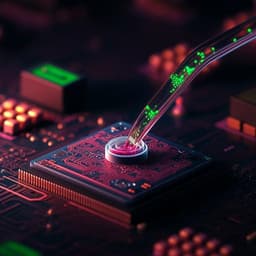
Medicine and Health
A magnetic multi-layer soft robot for on-demand targeted adhesion
Z. Chen, Y. Wang, et al.
Explore groundbreaking advancements in targeted adhesion with a magnetic multi-layer soft robot capable of agile movements and separation on demand. This innovative research showcases its effectiveness in the gastrointestinal tract, led by an expert team of researchers.
~3 min • Beginner • English
Introduction
The study addresses the challenge of assembling and controlling magnetic multi-layer soft robots for on-demand targeted adhesion in complex physiological environments, such as the gastrointestinal tract. Prior magnetic soft robots exhibit high shape reconfigurability and multimodal locomotion (rolling, crawling, swimming, jumping) under external magnetic fields and have been used in minimally invasive operations and targeted delivery. However, interlayer interactions in multi-layer, film-like soft robots remain insufficiently understood, limiting robust on-demand motion and separation for targeted adhesion. Gastric ulcers often occur at multiple sites, and bioadhesive platforms can prolong drug retention but require precise delivery. The authors propose a three-layer magnetic soft robot with engineered in-plane magnetic structures to enable stable assembly, navigated locomotion, magnetic pressing for rapid adhesion to wet tissues, and on-demand flipping-induced separation to achieve multiple targeted adhesions within the stomach.
Literature Review
The paper reviews magnetic soft robots’ programmable magnetization, high DoF deformations, and locomotion modes (rolling, crawling, swimming, jumping) enabling traversal of complex terrains. Prior biomedical applications include minimally invasive interventions (bioprinting, bladder assistance, neurovascular manipulation, biopsy) and targeted delivery in the GI tract and vasculature. Mucoadhesive coatings and microstructures aid locomotion and retention in wet, 3D environments. Bioadhesive platforms (patches, hydrogels) have been used to improve retention on gastric tissues; however, delivering them to multiple ulcers remains challenging. Existing works also demonstrate magnetic delivery of patches and wireless soft stents for on-demand drug release. The gap identified is the limited understanding and design of interlayer magnetic interactions for multi-layer robots to achieve on-demand separation and multi-site adhesion.
Methodology
Design and materials: A three-layer robot (Type I) comprises one center layer and two side layers. Each layer includes a soft magnetic substrate (NdFeB microparticles in PDMS) with magnetization perpendicular to the film and an embedded adhesive film composed of Carbopol (mucoadhesive), Poloxamer, and HPMC (film formation). Side layers: magnetic frame with nonmagnetic base; center layer: magnetic base with nonmagnetic frame. Interlayer attraction maintains assembly; magnetic pressing enhances tissue contact; adhesive-tissue interaction exceeds interlayer attraction to enable separation.
Fabrication: Magnetic slurry (NdFeB:PDMS=2:1 by mass) spin-coated into films. Adhesive film cast from ethanol/water (50/50 v/v) solution of Carbopol, HPMC, Poloxamer; Rhodamine B added for visualization; solvent evaporated with heat. Components laser-cut, plasma-treated, assembled into side and center layers, and magnetized under a pulsed field. Layers assembled via magnetic attraction. Dimensions for Type I in tests: 18×18×1.5 mm³; mass 0.612±0.054 g.
Mechanical and rheological characterization: Tensile testing (0.1 kN load cell, 50 mm min⁻1) on rectangular specimens to measure fracture stress/strain for five weight ratios (Carbopol : HPMC-Poloxamer mixture y from 1:6 to 5:6). Rheology (Anton Paar MCR302e): amplitude sweeps (0.01–100% strain at 1 Hz) and frequency sweeps (0.1–10 Hz at 1% strain), including immersion-time dependence to assess cohesive strength.
Adhesion testing (porcine gastric tissue): Lap-shear (ASTM F2255) and 180° T-peel (ASTM F2256). Adhesive film pressed between tissues at 1 kPa for specified times to study effects of composition, pressing time, and thickness (including 70 µm) on shear strength and interfacial toughness. Retention tests: reciprocal stretching of adhered monomers in simulated gastric fluid (SGF) at 0.25–1.25 Hz to measure retention time.
Magnetic actuation and locomotion: Translational motion induced by field gradient; analysis of magnetic force Fm versus friction Fr with variable horizontal distance L and vertical distance d. Tumbling under rotating fields (e.g., 20 mT, 0.2 Hz); step-out frequency characterization versus field strength for Type I–III robots (three-, two-, one-layer configurations).
Separation strategy (flipping): COMSOL simulations of a soft magnetic film under varying magnetic field strengths (0–50 mT) at fixed direction (α=30°) and under fixed strength (50 mT) with direction sweep (0–90°) to study stress, forces, and torques enabling flipping and separation from the adhered side layer. Experiments on wet gastric tissue used a magnet 15 mm below the tissue.
Ex-vivo experiments: Multi-target adhesion on flat porcine gastric tissue with three artificial ulcers and in a porcine stomach filled with fluid, navigated by ultrasound imaging. Adhesion formed by vertical magnetic attraction (≈2–5 min). Sequential separations from Type I→II and Type II→III achieved by reversing magnetic field direction.
In-vivo experiments (porcine): After anesthesia and laparotomy, stomach emptied and rinsed; three ~1 cm ulcers created on mucosa. Robot delivered via esophageal incision, tracked by real-time ultrasound, navigated to each ulcer for adhesion, performing sequential separations for multi-target coverage. Post-procedure ultrasound and dissection verified coverage. Biocompatibility: GES-1 cells co-cultured 24 h with adhesive film or magnetic substrate; LIVE/DEAD assay quantified viability.
Simulations: COMSOL with Young’s modulus G=3.2 MPa and magnetization M=152.076 kA m⁻1. Statistical analysis: mean±SD, n≥3, Student’s t test, significance at P≤0.05.
Key Findings
- Adhesive film mechanics: Among compositions tested, y=2:3 (Carbopol : HPMC-Poloxamer) achieved maximum fracture stress 23.08 ± 2.77 MPa and strain 21.04 ± 4.44%.
- Adhesion performance: Shear strength and interfacial toughness peaked at Carbopol:HPMC-Poloxamer = 1:2, reaching 7.10 ± 0.34 kPa and 29.44 ± 0.32 J/m², respectively. Adhesion vs pressing time on wet tissue peaked at 1 min contact under 1 kPa. Thickness dependence showed positive correlation up to ~70 µm, where shear strength and interfacial toughness plateaued at the above maxima.
- Hydration effects: Cohesive storage modulus G′ decreased with immersion time in SGF—amplitude sweep: 36.534 kPa (1 min) to 16.766 kPa (1 h); frequency sweep: 56.947 kPa to 26.686 kPa—while G′ remained higher than G″, indicating maintained crosslinked hydrogen-bond network.
- Retention under dynamic loading: In reciprocal stretching (0.25–1.25 Hz), retention time decreased with frequency. For a 70 µm film, retention fell from 26.098 ± 7.91 h at 0.25 Hz to 4.194 ± 0.434 h at 1.25 Hz.
- Translational locomotion: Modeling showed at d=15 mm vertical spacing, net external horizontal force >0 for L≈3.5–36 mm enabling translation; at d=30 mm, net force ≈0 (no motion). Experiments confirmed controllable translational speeds depending on magnet speed and d.
- Tumbling locomotion: Step-out frequency increased with magnetic field strength; multi-layer robots (Type I) showed higher step-out frequency than thinner configurations at B>15 mT. Translational speed during tumbling rose with frequency up to step-out, then declined due to desynchronization.
- On-demand separation (flipping): Simulations indicated 50 mT field sufficient for separation; increasing field strength and direction (0°→90°) elevated stress and enabled flipping around the contact point. Experiments on wet gastric tissue validated two-step separations: Type I→Type II, then Type II→Type III, by reversing field direction while adhered side layers remained on tissue.
- Ex-vivo multi-target adhesion: Sequential navigation and adhesion to three ulcer targets on flat gastric tissue and in an ex-vivo porcine stomach were successful under ultrasound guidance. Adhesion times (flat tissue) were 184 ± 102 s (first) and 382 ± 164 s (second). Adhesion remained after 12 h in SGF.
- In-vivo porcine stomach: Real-time ultrasound-guided navigation, coverage, adhesion, and sequential separations achieved multi-target adhesion on folded mucosa; post-dissection confirmed accurate coverage of three ulcers.
- Biocompatibility: GES-1 cell viability after 24 h co-culture: control 97.3%, adhesive film 99.0% (ns, P=0.90), magnetic substrate 97.5% (ns, P=0.15), indicating good in-vitro biocompatibility.
Discussion
The study demonstrates that engineering interlayer magnetic interactions and integrating a Carbopol-based mucoadhesive film enable a multi-layer magnetic soft robot to achieve navigated locomotion, rapid adhesion on wet gastric tissues, and on-demand flipping-induced separation. Tailored in-plane magnetic architectures (magnetic base vs frame) provide sufficient interlayer attraction for integrity during motion, while ensuring that tissue adhesion exceeds interlayer forces to allow controlled separation. The two locomotion modes (translational via gradients, tumbling via rotating fields) allow navigation across complex gastric surfaces, and the separation strategy permits multi-target coverage using a single deployed device. Quantitative mechanical and adhesion characterizations identify optimal adhesive composition (1:2 Carbopol:HPMC-Poloxamer) and thickness (~70 µm) for strong tissue adhesion and retention, while rheology clarifies hydration effects relevant to the gastric environment. Ex-vivo and in-vivo porcine experiments validate precise multi-target adhesion under ultrasound guidance, indicating translational potential for treating multiple gastric ulcers. These findings address the key challenge of interlayer interaction control in multi-layer soft robots and highlight their applicability for targeted GI interventions.
Conclusion
This work introduces a three-layer magnetic soft robot with distinct in-plane magnetic structures and an integrated Carbopol-based adhesive film that achieves on-demand targeted adhesion through controlled locomotion and flipping-based separation. The robot accomplishes multi-target adhesion in ex-vivo and in-vivo porcine stomachs under ultrasound guidance. Key contributions include: (1) design and modeling of interlayer magnetic interactions enabling stable assembly and controlled separation; (2) formulation and optimization of an adhesive film for wet-tissue adhesion; (3) demonstration of dual locomotion modes and an effective separation strategy for sequential multi-site coverage. Future directions include extending actuation range by increasing magnetic field strength/gradient (larger permanent magnets or higher-current, cooled electromagnets), applying X-ray guidance with barium for deep targets, employing robotic arms with permanent magnets for precise actuation, and loading therapeutics into the adhesive film to achieve combined coverage and drug delivery.
Limitations
- Magnetic actuation range is limited by field strength and gradients; at larger vertical distances (e.g., d≈30 mm), translational motion ceases, suggesting the need for stronger fields or closer proximity.
- Adhesion performance is sensitive to hydration and mucus; increased indwelling time was required for subsequent adhesions, likely due to mucus accumulation during navigation.
- Tumbling locomotion is constrained by step-out frequency; desynchronization at higher frequencies reduces speed.
- Current validation is in porcine models; clinical translation will require further in-vivo studies, long-term retention and safety assessments, and integration with clinical imaging/actuation systems.
- Adhesive film mechanical integrity degrades with higher cyclic loading frequencies, reducing retention time under aggressive dynamics.
Related Publications
Explore these studies to deepen your understanding of the subject.







